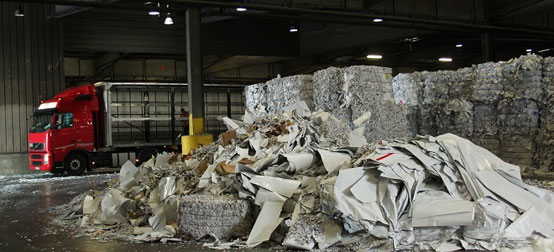The most sustainable book of its kind?
Jonathon Porritt wanted his new book, The World We Made, to be the
most sustainable of its kind ever made. How did the publishers and
printers go about it?
It's often assumed that e-books are the most environmentally friendly
form of the written word, but that's not necessarily true. As shown by
the production of Jonathon Porritt's new book, The World We Made, a
paper-based book that is sustainably designed and printed can have less
of an impact on the environment than an electronic equivalent; it all
depends on what criteria we use to define their sustainability.
Jonathon's book is written from the perspective of Alex McKay, a
history teacher looking back from 2050, reflecting on the technological,
environmental and social challenges that had to be overcome to create a
world that works for the majority of people.
 As Jonathon says, "A brilliant, fairer and genuinely sustainable
world is still available to all of us by 2050 - if we start making it
happen right now. As Jonathon says, "A brilliant, fairer and genuinely sustainable
world is still available to all of us by 2050 - if we start making it
happen right now.
So it was particularly important for me to leave no sustainable stone
uncovered when producing, creating and manufacturing this book."
Arjowiggins Graphic, a manufacturer of environmental paper solutions,
and Pureprint Group, an award-winning print and marketing company,
therefore set out to create the most sustainable book of its kind.
Printing The World We Made on four different types of 100 percent
recycled Forest Stewardship Council (FSC) certified paper reduced its
environmental impact by 17,120kg of landfill, 371,887 litres of water,
35,013kWh of electricity, 3,105kg of CO2 and greenhouse gases, and
27,817kg of wood, according to Arjowiggins Graphic's Environmental
Benefit Statement, which shows savings made by using recycled papers
compared with using virgin fibre papers (non-recyled papers).
Emissions
"The average CO2 emissions for a book is around 4kg of CO2, so we're
proud to have created a book that produces less than half of this
amount", says Angela de Vorchik of Arjowiggins Graphic. "Not only does
this reduce the book's carbon emissions and divert waste paper from
landfill but it also provides a really simple way to communicate its
commitment to the environment."
For the printing process, Pureprint Group, a carbon-neutral company
based in East Sussex, used inks made from vegetable-based oils, and no
isopropyl alcohol (which creates toxic emissions) was applied, to reduce
ground-level ozone. Pureprint also diverts 99.5 percent of all its waste
from landfill, only uses electricity produced from renewable resources
and was awarded the Queen's Award for Enterprise for Sustainable
Development in 2013. The book was despatched directly from the printers
to warehouses in the US, UK and Australia to cut out any unnecessary
transportation. Climate Care then offset residual emissions (1.8kg per
book) to make it completely carbon neutral.
Improvement
A big improvement on your typical printed book then - but how does
this compare with an e-book? Apple has stated that the total life cycle
of an iPad 2 will produce 130kg of CO2 emissions, which equates to the
CO2 emissions from about 32 books (based on the average of 4kg of CO2
per book across the publishing industry), or 72 copies of The World We
Made. That's roughly the number of books you'd need to read on an iPad
or other e-reader to realise its environmental benefits over a printed
book. Many tablets and e-readers also contain rare earth elements, which
are typically obtained in ethically unsound ways from warring regions of
Africa. What's more, these devices are often manufactured in China under
working conditions that would be considered unacceptable in the West.
And they're typically upgraded well before they reach the end of their
useful life, with last year's model ending in landfill or a toxic
e-waste dump in the developing world.
That's not to say the printing side of the book business is perfect -
far from it. Around 40 percent of all the books published each year end
up pulped, and there's still a way to go before all the paper used by
publishing industry is the recycled kind championed by the Arjowiggins
Graphic, sourced from certified suppliers such as the FSC. But as the
production methods employed on The World We Made demonstrate, truly
sustainable printed books need not be classified under 'fiction'. by
Duncan Jefferies
- GreenFutures |

